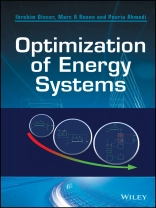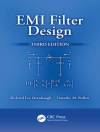An essential resource for optimizing energy systems to enhance design capability, performance and sustainability
Optimization of Energy Systems comprehensively describes the thermodynamic modelling, analysis and optimization of numerous types of energy systems in various applications. It provides a new understanding of the system and the process of defining proper objective functions for determination of the most suitable design parameters for achieving enhanced efficiency, cost effectiveness and sustainability.
Beginning with a general summary of thermodynamics, optimization techniques and optimization methods for thermal components, the book goes on to describe how to determine the most appropriate design parameters for more complex energy systems using various optimization methods. The results of each chapter provide potential tools for design, analysis, performance improvement, and greenhouse gas emissions reduction.
Key features:
- Comprehensive coverage of the modelling, analysis and optimization of many energy systems for a variety of applications.
- Examples, practical applications and case studies to put theory into practice.
- Study problems at the end of each chapter that foster critical thinking and skill development.
- Written in an easy-to-follow style, starting with simple systems and moving to advanced energy systems and their complexities.
A unique resource for understanding cutting-edge research in the thermodynamic analysis and optimization of a wide range of energy systems, Optimization of Energy Systems is suitable for graduate and senior undergraduate students, researchers, engineers, practitioners, and scientists in the area of energy systems.
สารบัญ
Acknowledgements xiii
Preface xv
1 Thermodynamic Fundamentals 1
1.1 Introduction 1
1.2 Thermodynamics 1
1.3 The First Law of Thermodynamics 2
1.3.1 Thermodynamic System 3
1.3.2 Process 3
1.3.3 Cycle 3
1.3.4 Heat 4
1.3.5 Work 4
1.3.6 Thermodynamic Property 4
1.3.6.1 Specific Internal Energy 4
1.3.6.2 Specific Enthalpy 5
1.3.6.3 Specific Entropy 5
1.3.7 Thermodynamic Tables 5
1.3.8 Engineering Equation Solver (EES) 6
1.4 The Second Law of Thermodynamics 12
1.5 Reversibility and Irreversibility 14
1.6 Exergy 14
1.6.1 Exergy Associated with Kinetic and Potential Energy 15
1.6.2 Physical Exergy 16
1.6.3 Chemical Exergy 16
1.6.3.1 Standard Chemical Exergy 16
1.6.3.2 Chemical Exergy of Gas Mixtures 17
1.6.3.3 Chemical Exergy of Humid Air 17
1.6.3.4 Chemical Exergy of Liquid Water and Ice 18
1.6.3.5 Chemical Exergy for Absorption Chillers 21
1.6.4 Exergy Balance Equation 23
1.6.5 Exergy Efficiency 24
1.6.6 Procedure for Energy and Exergy Analyses 24
1.7 Concluding Remarks 27
References 27
Study Questions/Problems 28
2 Modeling and Optimization 33
2.1 Introduction 33
2.2 Modeling 34
2.2.1 Air compressors 36
2.2.2 Gas Turbines 37
2.2.3 Pumps 38
2.2.4 Closed Heat Exchanger 39
2.2.5 Combustion Chamber (CC) 40
2.2.6 Ejector 41
2.2.7 Flat Plate Solar Collector 43
2.2.8 Solar Photovoltaic Thermal (PV/T) System 44
2.2.9 Solar Photovoltaic Panel 44
2.3 Optimization 47
2.3.1 System Boundaries 48
2.3.2 Objective Functions and System Criteria 48
2.3.3 Decision Variables 48
2.3.4 Constraints 48
2.3.5 Optimization Methods 49
2.3.5.1 Classical Optimization 49
2.3.5.2 Numerical Optimization Methods 49
2.3.5.3 Evolutionary Algorithms 50
2.4 Multi-objective Optimization 51
2.4.1 Sample Applications of Multi-objective Optimization 52
2.4.1.1 Economics 52
2.4.1.2 Finance 53
2.4.1.3 Engineering 53
2.4.2 Illustrative Example: Air Compressor Optimization 53
2.4.2.1 Thermodynamic and Economic Modeling and Analysis 53
2.4.2.2 Decision Variables 55
2.4.2.3 Constraints 56
2.4.2.4 Multi-objective Optimization 56
2.4.3 llustrative Example: Steam Turbine 58
2.4.3.1 Decision Variables 59
2.4.3.2 Constraints 59
2.4.3.3 Multi-objective Optimization 60
2.5 Concluding Remarks 61
References 63
Study Questions/Problems 63
3 Modeling and Optimization of Thermal Components 65
3.1 Introduction 65
3.2 Air Compressor 66
3.3 Steam Turbine 67
3.4 Pump 68
3.4.1 Modeling and Simulation of a Pump 69
3.4.2 Decision variables 69
3.4.3 Constraints 69
3.4.4 Multi-objective Optimization of a Pump 70
3.5 Combustion Chamber 73
3.5.1 Modeling and Analysis of a Combustion Chamber 73
3.5.1.1 Total Cost Rate 75
3.5.2 Decision Variables 75
3.5.3 Constraints 75
3.5.4 Multi-objective Optimization 76
3.6 Flat Plate Solar Collector 78
3.6.1 Modeling and Analysis of Collector 78
3.6.2 Decision Variables and Input Data 79
3.6.3 Constraints 79
3.6.4 Multi-objective Optimization 81
3.7 Ejector 81
3.7.1 Modeling and Analysis of an Ejector 83
3.7.2 Decision Variables and Constraints 85
3.7.3 Objective Functions and Optimization 85
3.8 Concluding Remarks 89
References 89
Study Questions/Problems 90
4 Modeling and Optimization of Heat Exchangers 92
4.1 Introduction 92
4.2 Types of Heat Exchangers 93
4.3 Modeling and Optimization of Shell and Tube Heat Exchangers 96
4.3.1 Modeling and Simulation 96
4.3.2 Optimization 99
4.3.2.1 Definition of Objective Functions 99
4.3.2.2 Decision Variables 99
4.3.3 Case Study 100
4.3.4 Model Verification 100
4.3.5 Optimization Results 101
4.3.6 Sensitivity Analysis Results 103
4.4 Modeling and Optimization of Cross Flow Plate Fin Heat Exchangers 103
4.4.1 Modeling and Simulation 105
4.4.2 Optimization 107
4.4.2.1 Decision Variables 108
4.4.3 Case Study 108
4.4.4 Model Verification 108
4.4.5 Optimization Results 109
4.4.6 Sensitivity Analysis Results 112
4.5 Modeling and Optimization of Heat Recovery Steam Generators 118
4.5.1 Modeling and Simulation 118
4.5.2 Optimization 121
4.5.2.1 Decision Variables 121
4.5.3 Case Study 121
4.5.4 Modeling Verification 122
4.5.5 Optimization Results 122
4.5.6 Sensitivity Analysis Results 128
4.6 Concluding Remarks 129
References 130
Study Questions/Problems 131
5 Modeling and Optimization of Refrigeration Systems 133
5.1 Introduction 133
5.2 Vapor Compression Refrigeration Cycle 134
5.2.1 Thermodynamic Analysis 135
5.2.2 Exergy Analysis 138
5.2.3 Optimization 144
5.2.3.1 Decision Variables 145
5.2.3.2 Optimization Results 146
5.3 Cascade Refrigeration Systems 150
5.4 Absorption Chiller 159
5.4.1 Thermodynamic Analysis 161
5.4.2 Exergy Analysis 162
5.4.3 Exergoeconomic Analysis 166
5.4.4 Results and Discussion 166
5.4.4.1 Optimization 174
5.4.4.2 Optimization Results 175
5.5 Concluding Remarks 178
References 178
Study Questions/Problems 179
6 Modeling and Optimization of Heat Pump Systems 183
6.1 Introduction 183
6.2 Air/Water Heat Pump System 184
6.3 System Exergy Analysis 186
6.4 Energy and Exergy Results 188
6.5 Optimization 193
6.6 Concluding Remarks 196
Reference 198
Study Questions/Problems 198
7 Modeling and Optimization of Fuel Cell Systems 199
7.1 Introduction 199
7.2 Thermodynamics of Fuel Cells 200
7.2.1 Gibbs Function 200
7.2.2 Reversible Cell Potential 201
7.3 PEM Fuel Cell Modeling 203
7.3.1 Exergy and Exergoeconomic Analyses 204
7.3.2 Multi-objective Optimization of a PEM Fuel Cell System 205
7.4 SOFC Modeling 212
7.4.1 Mathematical Model 212
7.4.2 Cost Analysis 215
7.4.3 Optimization 216
7.5 Concluding Remarks 219
References 219
Study Questions/Problems 219
8 Modeling and Optimization of Renewable Energy Based Systems 221
8.1 Introduction 221
8.2 Ocean Thermal Energy Conversion (OTEC) 222
8.2.1 Thermodynamic Modeling of OTEC 222
8.2.1.1 Flat Plate Solar Collector 223
8.2.1.2 Organic Rankine Cycle (ORC) 224
8.2.1.3 PEM Electrolyzer 225
8.2.2 Thermochemical Modeling of a PEM Electrolyzer 226
8.2.3 Exergy Analysis 227
8.2.4 Efficiencies 228
8.2.4.1 Exergy Efficiency 228
8.2.5 Exergoeconomic Analysis 228
8.2.5.1 Flat Plate Solar Collector in OTEC Cycle 228
8.2.5.2 OTEC Cycle 229
8.2.6 Results and Discussion 229
8.2.6.1 Modeling Validation and Simulation Code Results 229
8.2.6.2 Exergy Analysis Results 232
8.2.7 Multi-objective Optimization 237
8.2.7.1 Objectives 238
8.2.7.2 Decision Variables 238
8.2.8 Optimization Results 238
8.3 Solar Based Energy System 241
8.3.1 Thermodynamic Analysis 244
8.3.2 Exergoeconomic Analysis 246
8.3.3 Results and Discussion 246
8.3.3.1 Exergoeconomic Results 248
8.3.4 Sensitivity Analysis 250
8.3.5 Optimization 253
8.3.6 Optimization Results 254
8.4 Hybrid Wind–Photovoltaic–Battery System 256
8.4.1 Modeling 256
8.4.1.1 Photovoltaic (PV) Panel 256
8.4.1.2 Wind Turbine (WT) 262
8.4.1.3 Battery 262
8.4.2 Objective Function, Design Parameters, and Constraints 262
8.4.3 Real Parameter Genetic Algorithm 263
8.4.4 Case Study 264
8.4.5 Results and Discussion 265
8.5 Concluding Remarks 268
References 270
Study Questions/Problems 273
9 Modeling and Optimization of Power Plants 275
9.1 Introduction 275
9.2 Steam Power Plants 276
9.2.1 Modeling and Analysis 278
9.2.2 Objective Functions, Design Parameters, and Constraints 281
9.3 Gas Turbine Power Plants 283
9.3.1 Thermodynamic Modeling 284
9.3.1.1 Air Compressor 285
9.3.1.2 Air Preheater (AP) 286
9.3.1.3 Combustion Chamber (CC) 286
9.3.1.4 Gas Turbine 286
9.3.2 Exergy and Exergoeconomic Analyses 287
9.3.3 Environmental Impact Assessment 289
9.3.4 Optimization 290
9.3.4.1 Definition of Objective Functions 290
9.3.4.2 Decision Variables 291
9.3.4.3 Model Validation 291
9.3.5 Results and Discussion 292
9.3.6 Sensitivity Analysis 294
9.3.7 Summary 296
9.4 Combined Cycle Power Plants 297
9.4.1 Thermodynamic Modeling 298
9.4.1.1 Duct Burner 298
9.4.1.2 Heat Recovery Steam Generator (HRSG) 298
9.4.1.3 Steam Turbine (ST) 300
9.4.1.4 Condenser 300
9.4.1.5 Pump 300
9.4.2 Exergy Analysis 300
9.4.3 Optimization 301
9.4.3.1 Definition of Objectives 301
9.4.3.2 Decision Variables 302
9.4.3.3 Constraints 302
9.4.4 Results and Discussion 303
9.5 Concluding Remarks 312
References 313
Study Questions/Problems 314
10 Modeling and Optimization of Cogeneration and Trigeneration Systems 317
10.1 Introduction 317
10.2 Gas Turbine Based CHP System 321
10.2.1 Thermodynamic Modeling and Analyses 322
10.2.1.1 Air Preheater 322
10.2.1.2 Heat Recovery Steam Generator (HRSG) 323
10.2.2 Optimization 325
10.2.2.1 Single Objective Optimization 325
10.2.2.2 Multi-objective Optimization 331
10.2.2.3 Optimization Results 333
10.3 Internal Combustion Engine (ICE) Cogeneration Systems 342
10.3.1 Selection of Working Fluids 343
10.3.2 Thermodynamic Modeling and Analysis 344
10.3.2.1 Internal Combustion Engine 345
10.3.2.2 Organic Rankine Cycle 346
10.3.2.3 Ejector Refrigeration Cycle (ERC) 346
10.3.3 Exergy Analysis 348
10.3.4 Optimization 348
10.3.4.1 Decision Variables 350
10.3.4.2 Multi-objective optimization 350
10.4 Micro Gas Turbine Trigeneration System 362
10.4.1 Thermodynamic Modeling 362
10.4.1.1 Topping Cycle (Brayton Cycle) 362
10.4.1.2 Bottoming Cycle 362
10.4.1.3 Absorption Chiller 365
10.4.1.4 Domestic Water Heater 365
10.4.2 Exergy Analysis 365
10.4.3 Optimization 366
10.4.3.1 Definition of Objectives 366
10.4.3.2 Decision Variables 367
10.4.3.3 Evolutionary Algorithm: Genetic Algorithm 368
10.4.4 Optimization Results 368
10.4.5 Sensitivity Analysis 372
10.5 Biomass Based Trigeneration System 381
10.5.1 Thermodynamic Modeling 382
10.5.1.1 Gasifier 382
10.5.1.2 Multi-effect Desalination Unit 383
10.5.2 Exergy Analysis 386
10.5.3 Optimization 387
10.5.3.1 Decision Variables 390
10.5.4 Optimization Results 390
10.6 Concluding Remarks 392
References 393
Study Questions/Problems 396
11 Modeling and Optimization of Multigeneration Energy Systems 398
11.1 Introduction 398
11.2 Multigeneration System Based On Gas Turbine Prime Mover 401
11.2.1 Thermodynamic Modeling 403
11.2.1.1 Brayton Cycle 403
11.2.1.2 Bottoming Cycle 404
11.2.1.3 Absorption Chiller 406
11.2.1.4 Domestic Hot Water Heater 406
11.2.1.5 Organic Rankine Cycle 406
11.2.1.6 Heat Recovery Vapor Generator (HRVG) 408
11.2.2 Exergy Analysis 412
11.2.2.1 Exergy Efficiency 413
11.2.3 Economic Analysis 413
11.2.3.1 Brayton Cycle 413
11.2.3.2 Steam Cycle 414
11.2.3.3 ORC Cycle 415
11.2.3.4 Absorption Chiller 416
11.2.3.5 PEM Electrolyzer 417
11.2.3.6 Domestic Hot Water (DHW) Heater 417
11.2.3.7 Capital recovery factor (CRF) 417
11.2.4 Multi-objective Optimization 417
11.2.4.1 Definition of Objectives 417
11.2.4.2 Decision Variables 418
11.2.5 Optimization Results 418
11.3 Biomass Based Multigeneration Energy System 422
11.3.1 Thermodynamic Analysis 424
11.3.1.1 Biomass Combustion 424
11.3.1.2 ORC Cycle 425
11.3.1.3 Domestic Water Heater 426
11.3.1.4 Double-effect Absorption Chiller 426
11.3.1.5 Reverse Osmosis (RO) Desalination Unit 428
11.3.2 Exergy Analysis of the System 430
11.3.3 Economic Analysis of the System 431
11.3.3.1 Biomass Combustor and Evaporator 431
11.3.3.2 Heating Process Unit 432
11.3.3.3 Reverse Osmosis (RO) Desalination Unit 432
11.3.4 Multi-objective Optimization 432
11.3.4.1 Definition of Objectives 432
11.3.4.2 Decision Variables 433
11.3.5 Optimization Results 433
11.4 Concluding Remarks 443
References 443
Study Questions/Problems 444
Index 447
เกี่ยวกับผู้แต่ง
IBRAHIM DINCER is a tenured full professor of Mechanical Engineering in the Faculty of Engineering and Applied Science at UOIT. He is Vice President for Strategy in International Association for Hydrogen Energy (IAHE) and Vice-President for World Society of Sustainable Energy Technologies (WSSET). Renowned for his pioneering works in the area of sustainable energy technologies he has authored and co-authored numerous books and book chapters, more than a thousand refereed journal and conference papers, and many technical reports. He has chaired many national and international conferences, symposia, workshops and technical meetings. He has delivered more than 300 keynote and invited lectures. He is an active member of various international scientific organizations and societies, and serves as editor-in-chief, associate editor, regional editor, and editorial board member on various prestigious international journals. He is a recipient of several research, teaching and service awards, including the Premier’s research excellence award in Ontario, Canada, in 2004.
MARC A. ROSEN is a professor of Mechanical Engineering at the University of Ontario Institute of Technology in Oshawa, Canada, where he served as founding Dean of Engineering and Applied Science. Dr. Rosen is an active teacher and researcher in thermodynamics, energy technology, sustainable energy and the environmental impact of energy and industrial systems. He is a registered Professional Engineer in Ontario, and has served in many professional capacities, including being founding Editor-in-Chief of several journals, and a Director of Oshawa Power and Utilities Corporation. A Past-President of the Engineering Institute of Canada and the Canadian Society for Mechanical Engineering, Dr. Rosen received an Award of Excellence in Research and Technology Development from the Ontario Ministry of Environment and Energy, and is a Fellow of the Engineering Institute of Canada, the American Society of Mechanical Engineers, the Canadian Society for Mechanical Engineering, the Canadian Academy of Engineering and the International Energy Foundation.
POURIA AHMADI is a postdoctoral fellow in the Fuel Cell Research group at Simon Fraser University (SFU). He earned his Ph D in 2013 in mechanical engineering at the Clean Energy Research Lab at University of Ontario Institute of Technology, Canada. There, he worked on the design, analysis and optimization of advanced integrated energy systems for enhanced sustainability. Prior to joining SFU, he was a postdoctoral fellow at Ryerson University in Toronto, Ontario, where he worked on integrated renewable energy technologies for a net zero energy community in London, Ontario, Canada. He also worked as a research assistant and Ph D student at the advanced heat transfer lab at Sharif University of Technology, Tehran, Iran. He has 65 publications in both high ranked and peer-reviewed journals and international conference proceedings.












